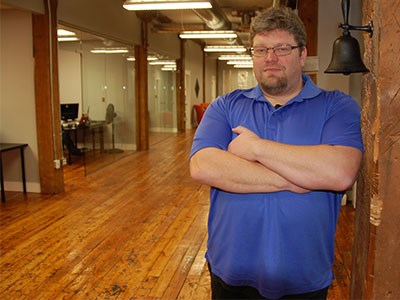A North Bay medical high-tech firm is preparing to enter new markets with its innovative physician-scheduling software.
To accommodate their growing ranks, the 12-employee MetricAid moved onto the second floor of a refurbished 100-year-old building in the city’s downtown last May.
“This building has a ton of character,” said managing director Les Blackwell, alluding to its exposed brick, beams and wood plank floors. “It’s been through many lives.”
A massive January 2012 fire ravaged parts of the building, displacing an importing business and a sporting goods store.
The former warehouse space has been sectioned off into individual offices with glass partitions combining both a private and collaborative environment with an open lounge and kitchen area for group gatherings.
“This shop would be right at home on King Street in Toronto,” said Blackwell. “We spent lot of time in the design of the space. I want people to be happy at work.”
It’s also a great recruiting tool, of which MetricAid can boast considerable success.
To bolster his development team, Blackwell repatriated three former North Bay natives who worked in southern Ontario, Ottawa and Las Vegas.
“As a politician myself (in nearby Strong Township), I know the value of bringing families back into the area.”
Co-founded by Blackwell and Dr. Scott Daley in 2012, MetricAid developed a proprietary scheduling algorithm to reduce emergency department wait times while ensuring adequate around-the-clock physician coverage.
“If you have a shift work job, your schedule is your life,” said Blackwell.
MetricAid staff prepare schedules for hospital clients, two to four months in advance, based on doctors’ input of their shift preferences.
As a third-party scheduler, they factor in vacations, private practice, doctors working at multiple sites, even wedding anniversaries.
“Our system is very good at gathering very granular data from them on what shifts they want to work, what shifts they can’t, and how they like them clustered,” said Blackwell.
At the same time, other variables like hourly patient volume are scored through the department and physicians’ individual performance in diagnosing patients.
Blackwell said it takes considerable technology and human brainpower to deliver a schedule that physicians like while ensuring patients receive care in a timely fashion.
“The point of all this is, we don’t want them to trade shifts based on their preference. We want you to stay there (once slotted in); that’s why we go through all this effort.”
The company has become a magnet for government funding, most recently pocketing more than $223,000 in development money from the Northern Ontario Heritage Fund last December.
“It levels the playing field for us,” said Blackwell in assisting with out-of-town travel and recruiting costs.
North Bay Regional Health Centre first signed up to their subscriber-based system, but the GTA has been their honey hole with the system deployed at Mount Sinai, North York General, Mackenzie Health in Richmond Hill, Brampton Civic Hospital and some affiliated urgent care centres.
Expansion into the U.S. through Philadelphia was briefly shelved while the company tackled the Ontario market, but they’re now ready to dust off those plans.
“We’re getting caught up,” said Blackwell. “We’re going to aggressively pursue U.S. business this year in hoping to land our first client by late summer or early fall.
“Philly is still the best market for us. They have a very high density of health care, the market is risk tolerant and they kind of like innovation down there.”
To enter the U.S., the company will obtain its HITRUST (Health Information Trust Alliance) certification, considered the gold standard for data protection.
“We have just about all the infrastructure in place to service four times as many clients as we have now,” he said. “We’re really ready now to start growing very quickly.”
Their more immediate goals are watching their Ontario clients “knock their wait times out of the park.”
Since implementing at Mackenzie and Brampton in January, Blackwell said they’ve cut one to two hours off their wait times, which should deliver “six-figure” rewards to both facilities under the Pay for Results Program, a Ministry of Health monetary incentive program.
“We’re very good at hitting those numbers. Our clients are all top performers in that program.”
Blackwell said their platform is easily transferrable to other sectors — “anywhere you’ve got people in waiting rooms” — but the medical field is where they prefer to operate. “Nurse scheduling is probably the next thing we’ll do.”
Under development is an automated version, he said, offering clients the option of building their own schedules.
“My ultimate goal for this company is that we would have an off-the-shelf offering in a couple of years that anyone can basically buy a licence to get the same results in their emergency.”




